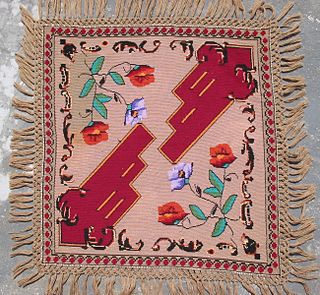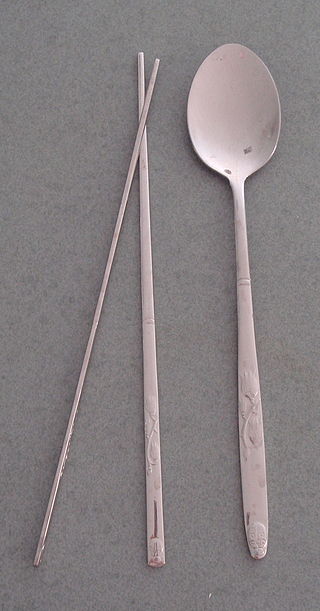
A knife is a tool or weapon with a cutting edge or blade, usually attached to a handle or hilt. One of the earliest tools used by humanity, knives appeared at least 2.5 million years ago, as evidenced by the Oldowan tools. Originally made of wood, bone, and stone, over the centuries, in step with improvements in both metallurgy and manufacturing, knife blades have been made from copper, bronze, iron, steel, ceramic, and titanium. Most modern knives have either fixed or folding blades; blade patterns and styles vary by maker and country of origin.

A teaspoon (tsp.) is an item of cutlery. It is a small spoon that can be used to stir a cup of tea or coffee, or as a tool for measuring volume. The size of teaspoons ranges from about 2.5 to 7.3 mL. For cooking purposes and dosing of medicine, a teaspoonful is defined as 5 mL, and standard measuring spoons are used.

A tablespoon is a large spoon. In many English-speaking regions, the term now refers to a large spoon used for serving; however, in some regions, it is the largest type of spoon used for eating.

A spoon is a utensil consisting of a shallow bowl, oval or round, at the end of a handle. A type of cutlery, especially as part of a place setting, it is used primarily for transferring food to the mouth (eating). Spoons are also used in food preparation to measure, mix, stir and toss ingredients and for serving food. Present day spoons are made from metal, wood, porcelain or plastic. There are many different types of spoons made from different materials by different cultures for different purposes and food.

In cutlery or kitchenware, a fork is a utensil, now usually made of metal, whose long handle terminates in a head that branches into several narrow and often slightly curved tines with which one can spear foods either to hold them to cut with a knife or to lift them to the mouth.

Various customary etiquette practices exist regarding the placement and use of eating utensils in social settings. These practices vary from culture to culture. Fork etiquette, for example, differs in Europe, the United States, and Southeast Asia, and continues to change. In East Asian cultures, a variety of etiquette practices govern the use of chopsticks.

Tableware items are the dishware and utensils used for setting a table, serving food, and dining. The term includes cutlery, glassware, serving dishes, serving utensils, and other items used for practical as well as decorative purposes. The quality, nature, variety and number of objects varies according to culture, religion, number of diners, cuisine and occasion. For example, Middle Eastern, Indian or Polynesian food culture and cuisine sometimes limits tableware to serving dishes, using bread or leaves as individual plates, and not infrequently without use of cutlery. Special occasions are usually reflected in higher quality tableware.

A tablecloth is a cloth used to cover a table. Some are mainly ornamental coverings, which may also help protect the table from scratches and stains. Other tablecloths are designed to be spread on a dining table before laying out tableware and food. Some tablecloths are designed as part of an overall table setting, with coordinating napkins, placemats, or other decorative pieces. Special kinds of tablecloth include "runners" which overhang the table at two ends only and "table protectors" which provide a padded layer under a normal tablecloth.

Sujeo (Korean: 수저) is the Korean term for the set of eating utensils commonly used to eat Korean cuisine. The word is a portmanteau of the words sutgarak and jeotgarak. The sujeo set includes a pair of oval-shaped or rounded-rectangular metal chopsticks, and a long handled shallow spoon of the same material. One may use both at the same time, but this is a recent way to eat quicker. It is not considered good etiquette to hold the spoon and the chopstick together in one hand especially while eating with elders. More often food is eaten with chopsticks alone. Sometimes the spoon apart from chopsticks is referred to as sujeo.

Table manners are the rules of etiquette used while eating and drinking together, which may also include the use of utensils. Different cultures observe different rules for table manners. Each family or group sets its own standards for how strictly these rules are to be followed.

A chopstick rest is tableware, similar to a knife rest or a spoon rest, used to keep chopstick tips off the table and to prevent used chopsticks from contaminating or rolling off tables. Chopstick rests are found more commonly in restaurants than in homes. They come in various shapes and are made from clay, wood, plastic, metal, glass, porcelain or precious stones such as jade. If the chopsticks come in paper sleeves, some people fold the sleeves into chopstick rests.

A spoon rest is a piece of kitchenware that serves as a place to lay spoons and other cooking utensils, to prevent cooking fluids from getting onto countertops, as well as keeping the spoon from touching any contaminants that might be on the counter. It is easier to keep the rest clean than the countertop.

Chopsticks are shaped pairs of equal-length sticks that have been used as kitchen and eating utensils in most of East Asia for over three millennia. They are held in the dominant hand, secured by fingers, and wielded as extensions of the hand, to pick up food.

Customs and etiquette in Chinese dining are the traditional behaviors observed while eating in Greater China. Traditional Han customs have spread throughout East Asia to varying degrees, with some regions sharing a few aspects of formal dining, which has ranged from guest seating to paying the bill.

The Chinese spoon or Chinese soup spoon is a type of spoon with a short, thick handle extending directly from a deep, flat bowl. It is a regular utensil in Chinese cuisine used for liquids, especially soups, or loose solid food. Most are made from ceramics. Although normally used as an eating utensil, larger versions of the Chinese spoon are also used as serving spoons or ladles. It can be stacked on top of one another for storage.

In South Korea, etiquette, or the code of social behavior that governs human interactions, is largely derived from Korean Confucianism and focuses on the core values of this religion. In addition to general behaviour, etiquette in South Korea also determines how to behave with responsibility and social status. Although most aspects of etiquette are accepted by the country at large, customs can be localized to specific regions or influenced by other cultures, namely China, Japan, and the United States.

Japanese dining etiquette is a set of traditional perceptions governing specific expectations which outlines general standards of how one should behave and respond in various dining situations.
Combination eating utensils, also known as hybrid utensils, are utensils that have the qualities of other utensils combined into one. This can be done to make a more convenient, less wasteful, or more cost-efficient product. Many different types of combination utensils have been created, each designed to serve a different purpose.
















